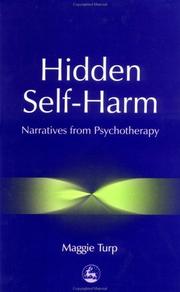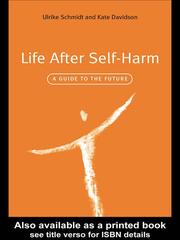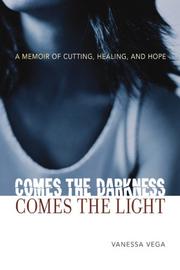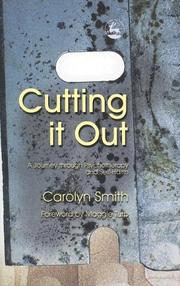| Listing 1 - 10 of 16 | << page >> |
Sort by
|

ISBN: 1135961115 1135961123 9786610543779 1280543779 0203903706 9780203903704 9780415924108 0415924103 9780415924115 0415924111 9781135961077 9781135961114 9781135961121 0704344408 Year: 1999 Publisher: New York : Routledge,
Abstract | Keywords | Export | Availability | Bookmark
 Loading...
Loading...Choose an application
- Reference Manager
- EndNote
- RefWorks (Direct export to RefWorks)
Hundreds of thousands of women self-mutilate, yet very little is known about the reasons for this widespread phenomenon or the experience of self-harming itself. Now, this powerful and accessible book gathers together the personal testimonies of a broad range of women who self-mutilate, explores the causes and effects of self-harming behavior and offers strategies for understanding, overcoming and healing from self-mutilation.
Self-mutilation. --- Women --- Automutilation --- Self-harm (Self-mutilation) --- Self-injurious behavior (Self-mutilation) --- Self-injury (Self-mutilation) --- Malingering --- Mutilation --- Self-destructive behavior --- Mental health. --- Health and hygiene --- Psychology

ISBN: 1283904047 1417502991 1846423643 9781417502998 9781846423642 9781853029011 1853029017 1853029017 9781283904049 Year: 2003 Publisher: London ; New York : Jessica Kingsley Publishers,
Abstract | Keywords | Export | Availability | Bookmark
 Loading...
Loading...Choose an application
- Reference Manager
- EndNote
- RefWorks (Direct export to RefWorks)
The book takes a new look at self-harm, focusing particularly on the under-explored area of `hidden' self-harming behaviour. These behaviours may not be immediately identifiable as self-harm by counsellors, therapists or their clients, but Turp shows how recognition and understanding of hidden self-harm can improve practice with those affected.
Psychotherapy --- Self-injurious behavior --- Self-mutilation --- Automutilation --- Self-harm (Self-mutilation) --- Self-injurious behavior (Self-mutilation) --- Self-injury (Self-mutilation) --- Malingering --- Mutilation --- Self-destructive behavior --- SIB (Behavior disorder) --- Stereotyped behavior (Psychiatry)
Book
ISBN: 1461634245 9786613929495 1283617048 9781461634249 9781283617048 073912465X 9780739124659 9780739124642 0739124641 Year: 2009 Publisher: Lanham, Md. : Lexington Books,
Abstract | Keywords | Export | Availability | Bookmark
 Loading...
Loading...Choose an application
- Reference Manager
- EndNote
- RefWorks (Direct export to RefWorks)
This book explores several topics pertaining to suicide and deliberate self-harm in the corrections setting, including who tends to commit these acts; where, when, and how these incidents occur; screening mechanisms; the role of environmental stimuli in facilitating or preventing acts of self harm; interpersonal relations among inmates and between inmates and staff; the role of the courts in setting and ruling on suicide prevention policies; and diversion and re-entry plans for offenders.
Prisoners --- Suicide --- Self-mutilation --- Automutilation --- Self-harm (Self-mutilation) --- Self-injurious behavior (Self-mutilation) --- Self-injury (Self-mutilation) --- Malingering --- Mutilation --- Self-destructive behavior --- Convicts --- Correctional institutions --- Imprisoned persons --- Incarcerated persons --- Prison inmates --- Inmates of institutions --- Persons --- Suicidal behavior --- Prevention. --- Inmates
Book
ISBN: 1536108774 9781536108774 1536108561 9781536108569 Year: 2017 Publisher: New York : Novinka,
Abstract | Keywords | Export | Availability | Bookmark
 Loading...
Loading...Choose an application
- Reference Manager
- EndNote
- RefWorks (Direct export to RefWorks)
Self-injurious behavior. --- Self-mutilation. --- Automutilation --- Self-harm (Self-mutilation) --- Self-injurious behavior (Self-mutilation) --- Self-injury (Self-mutilation) --- Malingering --- Mutilation --- Self-destructive behavior --- SIB (Behavior disorder) --- Stereotyped behavior (Psychiatry)
Book
ISBN: 1784501891 9781784501891 9781849057417 1849057419 1849057419 Year: 2016 Publisher: London, England ; Philadelphia, Pennsylvania : Jessica Kingsley Publishers,
Abstract | Keywords | Export | Availability | Bookmark
 Loading...
Loading...Choose an application
- Reference Manager
- EndNote
- RefWorks (Direct export to RefWorks)
A complete guide for parents and practitioners on understanding and treating self-injury in autism (ASD). With contributions by top experts, the book explains various forms of self-injury, discusses the treatment options available, including medical, psychiatric and nutritional treatments, and considers the effectiveness of integrated approaches.
Autistic children --- Self-mutilation --- Automutilation --- Self-harm (Self-mutilation) --- Self-injurious behavior (Self-mutilation) --- Self-injury (Self-mutilation) --- Malingering --- Mutilation --- Self-destructive behavior --- Autism in children --- Children with autism --- Autistic people --- Children with autism spectrum disorders --- Treatment. --- Patients
Book
ISBN: 9780231542500 023154250X 9780231177900 0231177909 Year: 2018 Publisher: New York, NY : Columbia University Press,
Abstract | Keywords | Export | Availability | Bookmark
 Loading...
Loading...Choose an application
- Reference Manager
- EndNote
- RefWorks (Direct export to RefWorks)
"Picturing myself dying in a way I choose myself seems so comforting, healing and heroic. I'd look at my wrists, watch the blood seeping, and be a spectator in my last act of self-determination. By having lost all my self-respect it seems like the last pride I own, determining the time I die."-Kyra V., seventeenReading the confessions of a teenager contemplating suicide is uncomfortable, but we must do so to understand why self-harm has become epidemic, especially in the United States. What drives teenagers to self-harm? What makes death so attractive, so liberating, and so inevitable for so many? In Teenage Suicide Notes, sociologist Terry Williams pores over the writings of a diverse group of troubled youths to better grasp the motivations behind teenage suicide and to humanize those at risk of taking their own lives.Williams evaluates young people in rural and urban contexts and across lines of race, class, gender, and sexual orientation. His approach, which combines sensitive portrayals with sociological analysis, adds a clarifying dimension to the fickle and often frustrating behavior of adolescents. Williams reads between the lines of his subjects' seemingly straightforward reflections on alienation, agency, euphoria, and loss, and investigates how this cocktail of emotions can lead to suicide-or not. Rather than treating these notes as exceptional examples of self-expression, Williams situates them at the center of teenage life, linking them to abuse, violence, depression, anxiety, religion, peer pressure, sexual identity, and family dynamics. He captures the currents that turn self-destruction into an act of self-determination and proposes more effective solutions to resolving the suicide crisis.
Teenagers --- Adolescent psychology --- Self-mutilation --- Self-destructive behavior --- Self-destructiveness --- Psychology, Pathological --- Automutilation --- Self-harm (Self-mutilation) --- Self-injurious behavior (Self-mutilation) --- Self-injury (Self-mutilation) --- Malingering --- Mutilation --- Suicidal behavior

ISBN: 0203505220 9780203505229 020359357X 9780203593578 1583918426 9781135446833 1135446830 9781135446789 1135446784 9781135446826 1135446822 9781138146037 113814603X 9781583918425 1583918426 1280077905 9781280077906 9786610077908 6610077908 Year: 2004 Publisher: Hove ; New York : Brunner-Routledge,
Abstract | Keywords | Export | Availability | Bookmark
 Loading...
Loading...Choose an application
- Reference Manager
- EndNote
- RefWorks (Direct export to RefWorks)
In many countries there has been an alarming increase in rates of suicide and self-harm, yet the stigma attached to these difficulties often leads to sub-optimal care.Life After Self-Harm: A Guide to the Future is written for individuals who have deliberately harmed themselves. Developed through a major research project the contents of the manual have been informed and shaped by many users and expert professionals. Illustrated with multiple case-histories, it teaches users important skills:for understanding and evaluating self-harmfor keeping safe in cri
Self-mutilation --- Self-injurious behavior --- Psychotherapy --- SIB (Behavior disorder) --- Stereotyped behavior (Psychiatry) --- Automutilation --- Self-harm (Self-mutilation) --- Self-injurious behavior (Self-mutilation) --- Self-injury (Self-mutilation) --- Malingering --- Mutilation --- Self-destructive behavior

ISBN: 1281128716 9786611128715 0814400914 9780814400913 9781281128713 0814474233 9780814474235 6611128719 Year: 2007 Publisher: New York : AMACOM,
Abstract | Keywords | Export | Availability | Bookmark
 Loading...
Loading...Choose an application
- Reference Manager
- EndNote
- RefWorks (Direct export to RefWorks)
Self-mutilation --- Self-injurious behavior --- Psychotherapy. --- Psychagogy --- Therapy (Psychotherapy) --- Mental illness --- Clinical sociology --- Mental health counseling --- SIB (Behavior disorder) --- Stereotyped behavior (Psychiatry) --- Automutilation --- Self-harm (Self-mutilation) --- Self-injurious behavior (Self-mutilation) --- Self-injury (Self-mutilation) --- Malingering --- Mutilation --- Self-destructive behavior --- Patients --- Treatment --- Vega, Vanessa, --- Health.

ISBN: 1846424569 1280566272 9786610566266 9781846424564 1843102668 9781843102663 Year: 2006 Publisher: Philadelphia, PA : Jessica Kingsley Publishers,
Abstract | Keywords | Export | Availability | Bookmark
 Loading...
Loading...Choose an application
- Reference Manager
- EndNote
- RefWorks (Direct export to RefWorks)
The first-person narrative offers a vividly honest voice to the feelings and compulsions that drive someone to harm themselves and explores the conflict between the desire to self-harm and the struggle to control and overcome this addictive, self-destructive behaviour. It also explores the complex nature of her relationship with her therapist.
Psychotherapy. --- Self-injurious behavior --- Self-mutilation --- Automutilation --- Self-harm (Self-mutilation) --- Self-injurious behavior (Self-mutilation) --- Self-injury (Self-mutilation) --- Malingering --- Mutilation --- Self-destructive behavior --- SIB (Behavior disorder) --- Stereotyped behavior (Psychiatry) --- Psychagogy --- Therapy (Psychotherapy) --- Mental illness --- Clinical sociology --- Mental health counseling --- Patients --- Treatment --- Smith, Carolyn, --- Health.
Book
ISBN: 1280124024 9786613527882 0857003062 9780857003065 9781849051729 1849051720 Year: 2012 Publisher: London : Jessica Kingsley Publishers,
Abstract | Keywords | Export | Availability | Bookmark
 Loading...
Loading...Choose an application
- Reference Manager
- EndNote
- RefWorks (Direct export to RefWorks)
This is a practical guide for professionals on understanding and responding to self-harm in children and adolescents. It includes information about what self-harm is and who is likely to self-harm, and provides practical advice on how to identify self-harm, how to respond and intervene, and how to support the child or young person.
Self-mutilation. --- Adolescent psychology. --- Child psychology. --- Behavior, Child --- Child behavior --- Child study --- Children --- Pediatric psychology --- Child development --- Developmental psychology --- Adolescence --- Teenagers --- Psychology --- Automutilation --- Self-harm (Self-mutilation) --- Self-injurious behavior (Self-mutilation) --- Self-injury (Self-mutilation) --- Malingering --- Mutilation --- Self-destructive behavior
| Listing 1 - 10 of 16 | << page >> |
Sort by
|

 Search
Search Feedback
Feedback About UniCat
About UniCat  Help
Help News
News